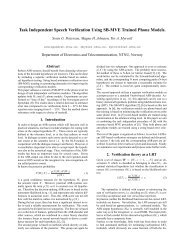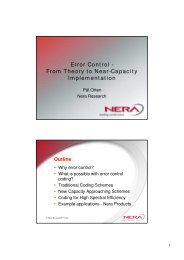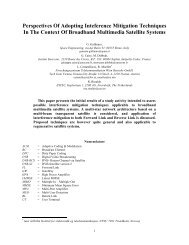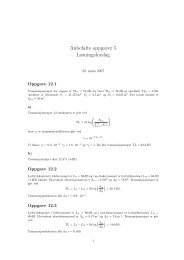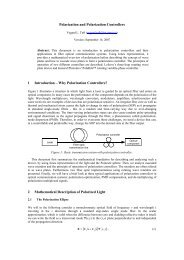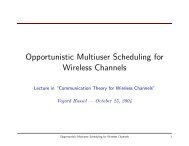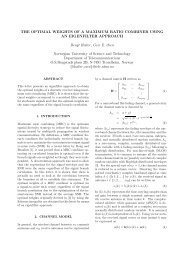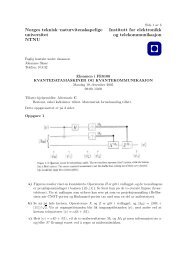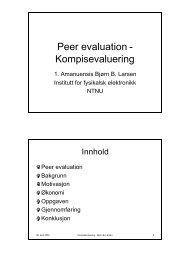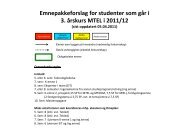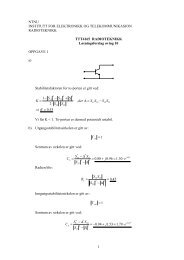Lab 4 Laser - Institutt for elektronikk og telekommunikasjon - NTNU
Lab 4 Laser - Institutt for elektronikk og telekommunikasjon - NTNU
Lab 4 Laser - Institutt for elektronikk og telekommunikasjon - NTNU
You also want an ePaper? Increase the reach of your titles
YUMPU automatically turns print PDFs into web optimized ePapers that Google loves.
1.1 <strong>Laser</strong> safety 5<br />
Class Power Hazards Precautions Examples<br />
I ≤ 4µW None none, ”exempt” UPC Scanners<br />
II > 4µW<br />
≤ 1mW<br />
Retina damage<br />
<strong>Laser</strong>pointers,<br />
small HeNe lasers<br />
IIIa<br />
> 1mW<br />
≤ 10mW<br />
possible after 10<br />
seconds or more<br />
of steady direct<br />
viewing<br />
Retina damage<br />
possible in 0.25<br />
seconds<br />
IIIb > 10mW Retina damage<br />
≤ 0.5W likely in 0.1<br />
seconds.<br />
IV > 0.5W Severe eye or skin<br />
damage from direct<br />
exposure.<br />
Eye damage likely<br />
from indirect exposure.<br />
Can ignite flammable<br />
materials<br />
<strong>Lab</strong>elling and warnings<br />
do not stare into<br />
beam<br />
Trained operators<br />
attached beam stop<br />
warninglamp<br />
contain beams<br />
Key switch<br />
interlock connector<br />
eye protection<br />
trained personnel<br />
only<br />
emission delay<br />
intracavity shutter<br />
door interlock<br />
contain all reflections<br />
HeNe and semicounductor<br />
laserpointers<br />
Semiconductor<br />
Dye<br />
Cutters, welders<br />
laser shows<br />
pulsed lasers<br />
argon lasers<br />
Table 1.1: Summary of ANSI and CDRH <strong>Laser</strong> Classes (see Winburn 1990, Ch.<br />
6)<br />
1.1.3 Rules of thumb when working with lasers<br />
The following rules of thumb will prevent accidents that can damage vision. If<br />
in doubt of the safety of any situation, seek the advise of the lab instructor.<br />
1. Know the appropriate laser Class(see table 1.1) and necessary precautions.<br />
2. Do not look into a laser beam under any circumstances!<br />
3. Control and confine all laser beams.<br />
4. Use beam stops and carefully plan the placement and movement of optical<br />
elements.<br />
5. Beware of stray reflections from the many surfaces the beams might encounter.<br />
6. Confine the beams to the horizontal plane just above the table.<br />
7. Keep your eyes above the level of the laser beams. (see rule 7)



